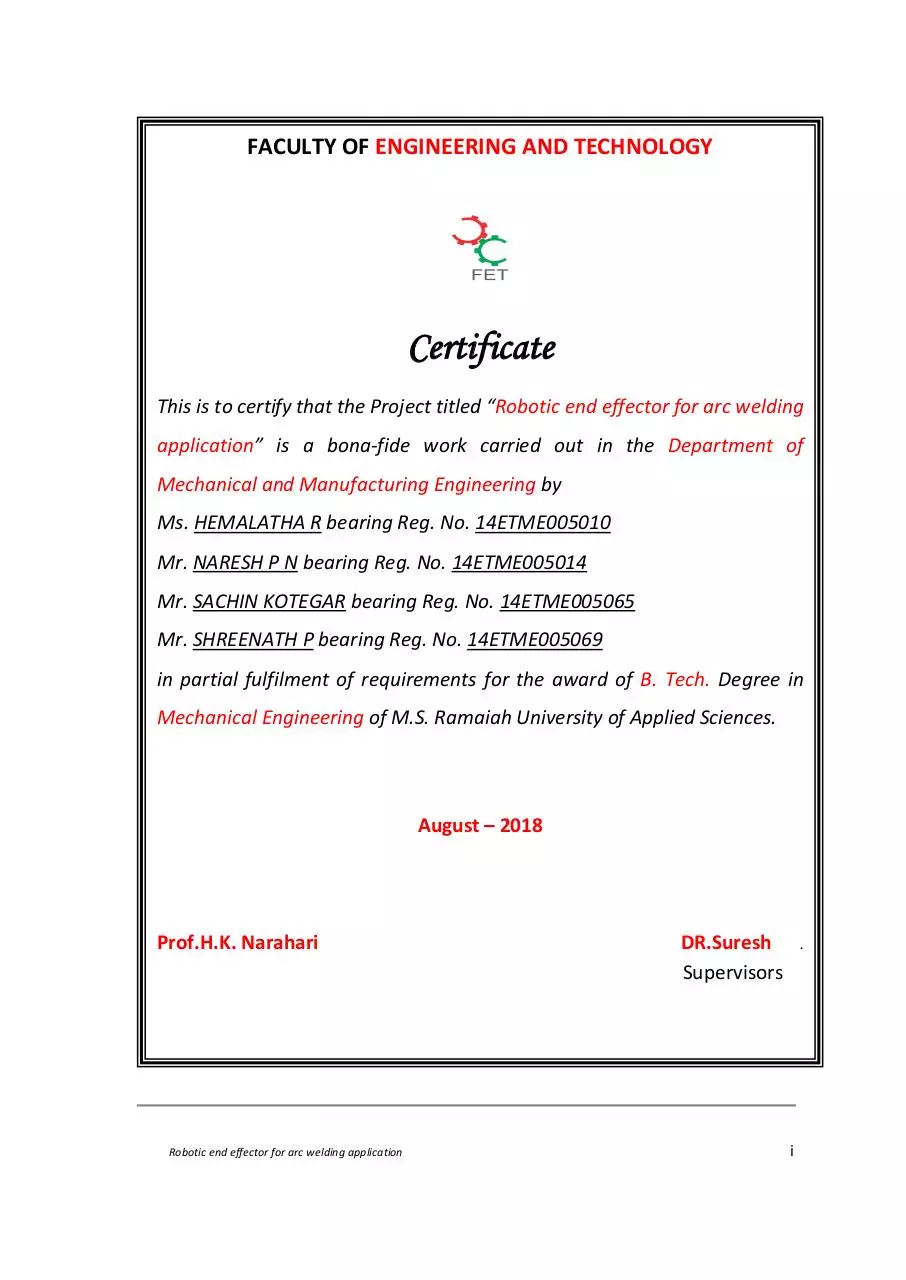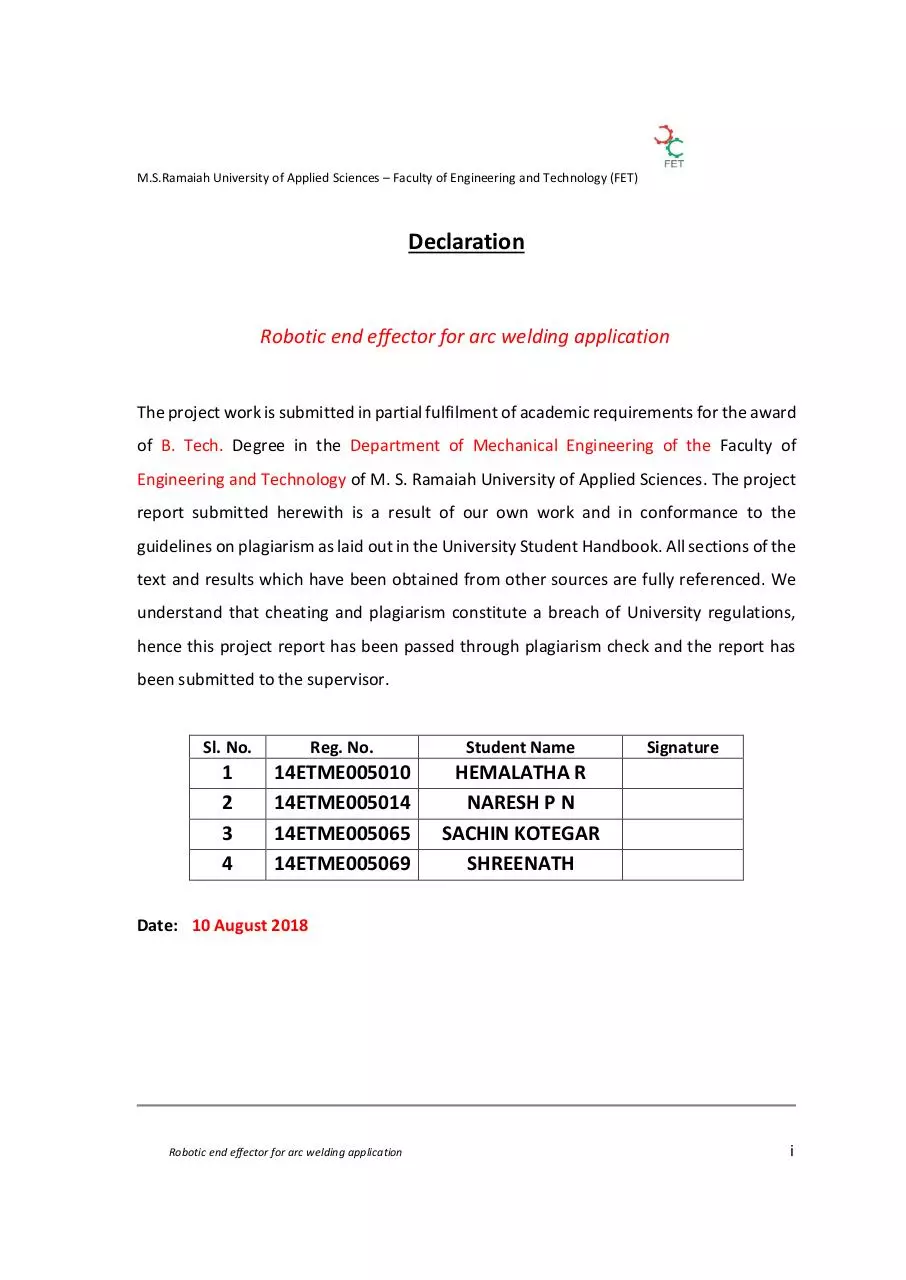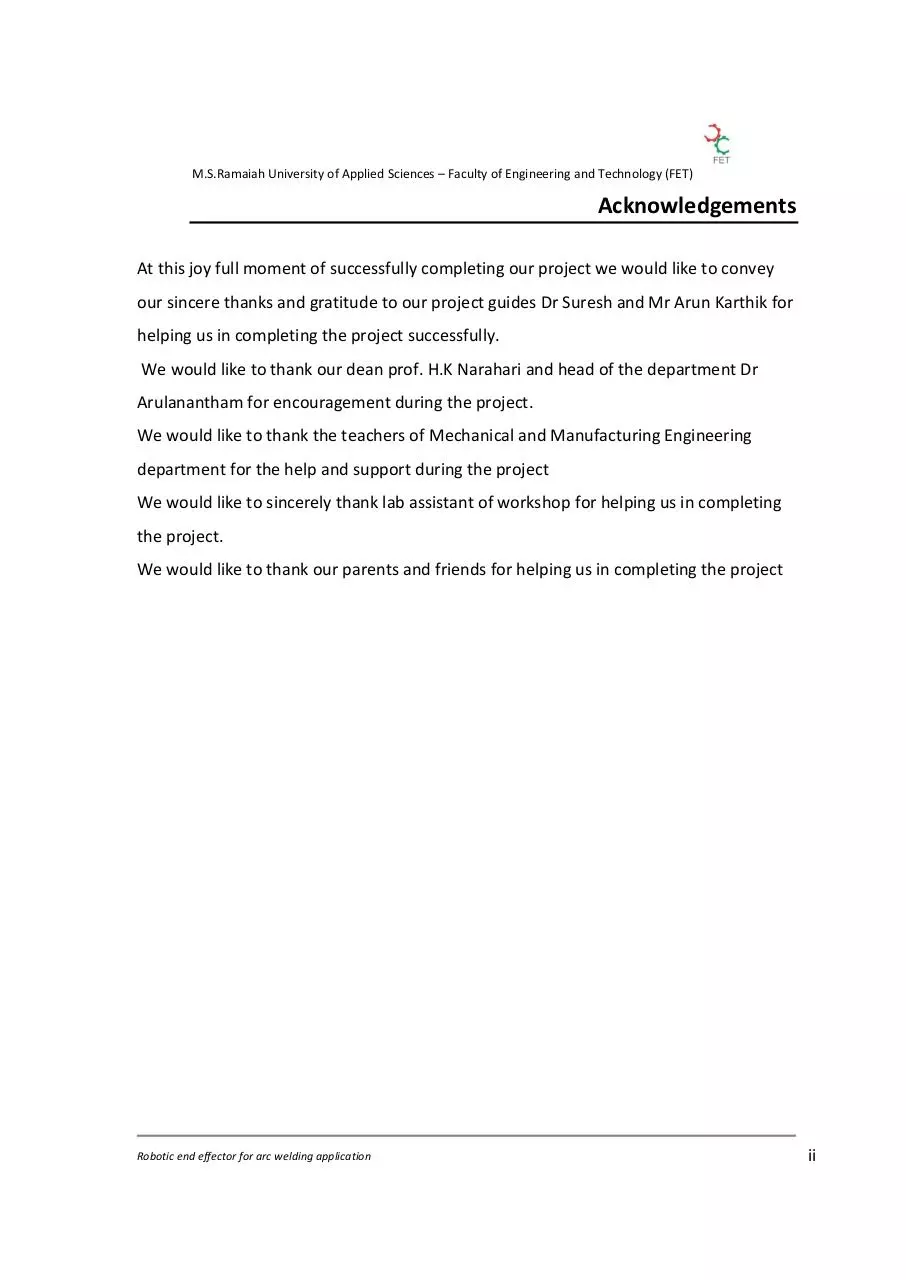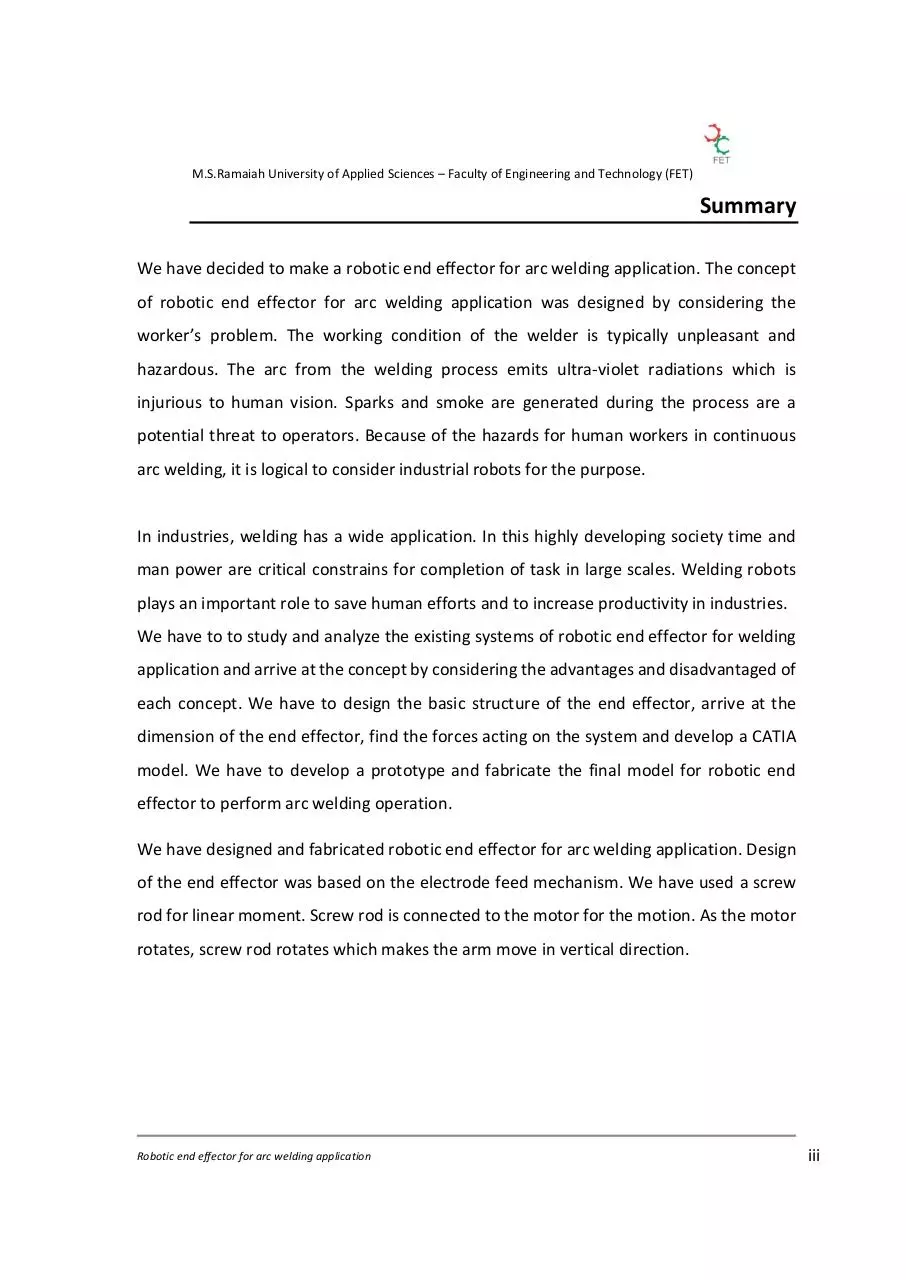DOC 20170513 WA0001 (PDF)
File information
Title: XXXXXXXXXXXXXXXXXXXXXXXXXXXXXXXXXXXXXXXXXXX(Title)
Author: usha
This PDF 1.5 document has been generated by Microsoft® Word 2016, and has been sent on pdf-archive.com on 13/05/2017 at 21:35, from IP address 157.49.x.x.
The current document download page has been viewed 538 times.
File size: 3.46 MB (54 pages).
Privacy: public file





File preview
Robotic end effector for arc welding application
Project Team
Sl. No.
Reg. No.
Student Name
1
2
3
4
14ETME005010
14ETME005014
14ETME005065
14ETME005069
HEMALATHA R
NARESH P N
SACHIN KOTEGAR
SHREENATH P
Supervisors: 1. Dr Suresh
2. Mr. Arun Karthik
August – 2018
B.Tech
FACULTY OF ENGINEERING AND TECHNOLOGY
M. S. RAMAIAH UNIVERSITY OF APPLIED SCIENCES
Bengaluru -560 054
Robotic end effector for arc welding application
i
FACULTY OF ENGINEERING AND TECHNOLOGY
Certificate
This is to certify that the Project titled “Robotic end effector for arc welding
application” is a bona-fide work carried out in the Department of
Mechanical and Manufacturing Engineering by
Ms. HEMALATHA R bearing Reg. No. 14ETME005010
Mr. NARESH P N bearing Reg. No. 14ETME005014
Mr. SACHIN KOTEGAR bearing Reg. No. 14ETME005065
Mr. SHREENATH P bearing Reg. No. 14ETME005069
in partial fulfilment of requirements for the award of B. Tech. Degree in
Mechanical Engineering of M.S. Ramaiah University of Applied Sciences.
August – 2018
Prof.H.K. Narahari
Dr. M. Arulanantham
Head – Dept. of MME
Robotic end effector for arc welding application
DR.Suresh
Supervisors
.
Prof. H. K. Narahari
Dean-FET
i
M.S.Ramaiah University of Applied Sciences – Faculty of Engineering and Technology (FET)
Declaration
Robotic end effector for arc welding application
The project work is submitted in partial fulfilment of academic requirements for the award
of B. Tech. Degree in the Department of Mechanical Engineering of the Faculty of
Engineering and Technology of M. S. Ramaiah University of Applied Sciences. The project
report submitted herewith is a result of our own work and in conformance to the
guidelines on plagiarism as laid out in the University Student Handbook. All sections of the
text and results which have been obtained from other sources are fully referenced. We
understand that cheating and plagiarism constitute a breach of University regulations,
hence this project report has been passed through plagiarism check and the report has
been submitted to the supervisor.
Sl. No.
Reg. No.
Student Name
1
2
3
4
14ETME005010
14ETME005014
14ETME005065
14ETME005069
HEMALATHA R
NARESH P N
SACHIN KOTEGAR
SHREENATH
Signature
Date: 10 August 2018
Robotic end effector for arc welding application
i
M.S.Ramaiah University of Applied Sciences – Faculty of Engineering and Technology (FET)
Acknowledgements
At this joy full moment of successfully completing our project we would like to convey
our sincere thanks and gratitude to our project guides Dr Suresh and Mr Arun Karthik for
helping us in completing the project successfully.
We would like to thank our dean prof. H.K Narahari and head of the department Dr
Arulanantham for encouragement during the project.
We would like to thank the teachers of Mechanical and Manufacturing Engineering
department for the help and support during the project
We would like to sincerely thank lab assistant of workshop for helping us in completing
the project.
We would like to thank our parents and friends for helping us in completing the project
Robotic end effector for arc welding application
ii
M.S.Ramaiah University of Applied Sciences – Faculty of Engineering and Technology (FET)
Summary
We have decided to make a robotic end effector for arc welding application. The concept
of robotic end effector for arc welding application was designed by considering the
worker’s problem. The working condition of the welder is typically unpleasant and
hazardous. The arc from the welding process emits ultra-violet radiations which is
injurious to human vision. Sparks and smoke are generated during the process are a
potential threat to operators. Because of the hazards for human workers in continuous
arc welding, it is logical to consider industrial robots for the purpose.
In industries, welding has a wide application. In this highly developing society time and
man power are critical constrains for completion of task in large scales. Welding robots
plays an important role to save human efforts and to increase productivity in industries.
We have to to study and analyze the existing systems of robotic end effector for welding
application and arrive at the concept by considering the advantages and disadvantaged of
each concept. We have to design the basic structure of the end effector, arrive at the
dimension of the end effector, find the forces acting on the system and develop a CATIA
model. We have to develop a prototype and fabricate the final model for robotic end
effector to perform arc welding operation.
We have designed and fabricated robotic end effector for arc welding application. Design
of the end effector was based on the electrode feed mechanism. We have used a screw
rod for linear moment. Screw rod is connected to the motor for the motion. As the motor
rotates, screw rod rotates which makes the arm move in vertical direction.
Robotic end effector for arc welding application
iii
M.S.Ramaiah University of Applied Sciences – Faculty of Engineering and Technology (FET)
Table of Contents
Certificate ……………………………………………………………………………………………………………….…(ii)
Declaration………………………………………………………………………….……..................................(iii)
Acknowledgements……………………………………………………………..…………………………………….(iv)
Summary …………………………………………………..……………………………………………………………..…(v)
Table of Contents………………………………………….……………………………………………………..…. (vi)
List of Tables……………………………………………….………………………………………………………..…..(x)
List of Figures……………………………………………………………………………………..………………….…(xi)
Nomenclature………………………………………………………………………………………………………….(xii)
Abbreviations and Acronyms……………………………………………………………………………..……(xiii)
Chapter-1: Introduction………………………………………………………..…………..………………………01
Preamble to the Chapter
1.1 Introduction
1.1.1 Advantages of using industrial robots ………………………………….01
Chapter-2: Background Theory
Preamble to the Chapter
2.1 Types of end effector……………………………………………………………………………....02
2.2 Definition of Welding……………………………………………………………………………….03
2.3 Principle of arc welding…………………………………………………………………………….03
2.4 Advantage of welding robot …………………………………………………………………….04
2.5 Problem Statement………………………………………………………………………………….04
2.6 Design Challenges……………………………………………………………………………………..04
Chapter-3:Aim and Objectives
Preamble to the Chapter
3.1 Title of the Project………………………………………………………………………………….06
3.2 Aim of the Project…………………………………………………………………………………..06
3.3 Objectives of the Project…………………………………………………………………………06
Robotic end effector for arc welding application
iv
M.S.Ramaiah University of Applied Sciences – Faculty of Engineering and Technology (FET)
3.4 Methods and Methodology……………………………………………………………………07
Chapter-4: Problem Solving
Preamble to the Chapter
4.1 Literature Review……………………………………………………………………………………09
4.1.1 Concept 1: Double drive roll mechanism……………………………………….09
4.1.2 Concept 2: Drive roll mechanism…………………………………………………..11
4.1.3 Concept 3: Fixed support roll mechanism…………………………………..…13
4.2 Comparing the concept of each mechanism……………………………………………14
4.3 Arriving at the concept……………………………………………………………………………14
4.4 Design consideration for the end effector……………………………………………….15
4.5 Designing the structure of the end effector for vertical movement…………16
4.6 Components required for designing the end effector………………………………16
4.7 Construction of this mechanism……………………………………………………………….17
4.8 Working of this mechanism………………………………………………………………………17
4.9 Dimension of the mechanism……………………………………………………………………18
4.10 Details of the component used……………………………………………………………...19
4.11 Designing the structure of the end effector for horizontal movement…..20
4.12 Components requited for designing this mechanism …………………………….23
4.13 Construction of this mechanism …………………………………………………………….24
4.14 Working of this mechanism……………………………………………………………………24
4.15 Dimensions of the mechanism……………………………………………………………….25
4.16 Details of the components used…………………………………………………………….25
4.17 Selection of the motor…………………………………………………………………………..27
4.18 Calculations …………………………………………………………………………………………..29
4.19 Simulation of horizontal mechanism in ADAMS simulation…………………….32
4.20 Simulation of vertical mechanism in ADAMA simulation………………………..33
4.21 CATIA model…………………………………………………………………………………………..33
Robotic end effector for arc welding application
v
M.S.Ramaiah University of Applied Sciences – Faculty of Engineering and Technology (FET)
Chapter-5: Results
Preamble to the Chapter
Chapter-6: Project Costing
Chapter-7: Conclusions and Suggestions for Future Work
Preamble to the Chapter
References
Robotic end effector for arc welding application
vi
M.S.Ramaiah University of Applied Sciences – Faculty of Engineering and Technology (FET)
List of Tables
List of tables
Table 2.1
Table containing methods and methodology……………….………………………08
Table 4.1
Table containing comparison of each mechanism …………………………….…14
Table 6.1
List of cost of the components……………………………………………………………..41
Robotic end effector for arc welding application
vii
Download DOC-20170513-WA0001
DOC-20170513-WA0001.pdf (PDF, 3.46 MB)
Download PDF
Share this file on social networks
Link to this page
Permanent link
Use the permanent link to the download page to share your document on Facebook, Twitter, LinkedIn, or directly with a contact by e-Mail, Messenger, Whatsapp, Line..
Short link
Use the short link to share your document on Twitter or by text message (SMS)
HTML Code
Copy the following HTML code to share your document on a Website or Blog
QR Code to this page

This file has been shared publicly by a user of PDF Archive.
Document ID: 0000596403.